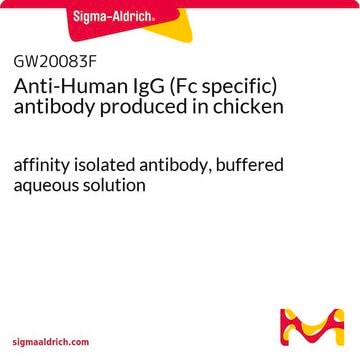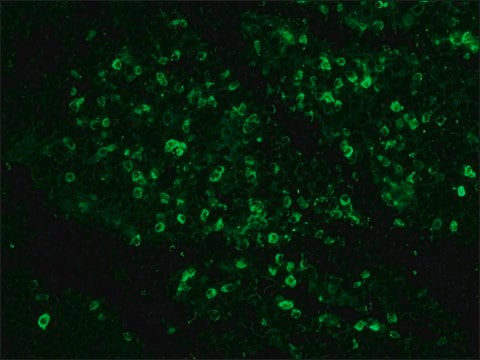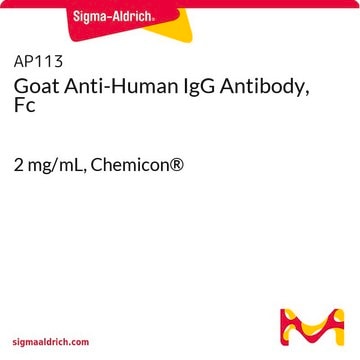I2136
Anti-Human IgG (Fc specific) antibody produced in goat
affinity isolated antibody, buffered aqueous solution
Synonym(s):
Anti Human IgG Fc - Anti-Human IgG (Fc specific) antibody produced in goat, Anti Human Igg, Anti Human Igg Antibody, Anti-Human Igg, Anti-Human Igg Fc, Goat Anti Human Igg
About This Item
Recommended Products
biological source
goat
conjugate
unconjugated
antibody form
affinity isolated antibody
antibody product type
secondary antibodies
clone
polyclonal
form
buffered aqueous solution
technique(s)
indirect ELISA: 1:10,000
shipped in
dry ice
storage temp.
−20°C
target post-translational modification
unmodified
Looking for similar products? Visit Product Comparison Guide
General description
Immunoglobulins comprise of two fragment antigen binding (Fab) and one fragment crystallizable (Fc) domains. The gene encoding IgG gene cluster is located on human chromosome 14.
Anti-Human IgG (Fc specific) antiserum is produced in goat using purified human IgG, Fc fragment, as the immunogen. Affinity isolated antibody is obtained from goat anti-human IgG antiserum by immunospecific purification which removes essentially all goat serum proteins, including immunoglobulins, which do not specifically bind to the Fc fragment of human IgG.
Specificity
Immunogen
Application
- in double-capture ELISA to measure antiglobulin responses in serum of transplant patients treated with CD52 monoclonal antibodies (CAMPATH-1G)
- in detection of IgG levels rheumatoid arthritis patients
- in small intestine biopsies
- in patients with acute myocardial infarction by immunoblotting
Enzyme-linked immunosorbent assay (1 paper)
Biochem/physiol Actions
Physical form
Storage and Stability
Disclaimer
Not finding the right product?
Try our Product Selector Tool.
Storage Class Code
12 - Non Combustible Liquids
WGK
WGK 3
Flash Point(F)
Not applicable
Flash Point(C)
Not applicable
Personal Protective Equipment
Certificates of Analysis (COA)
Search for Certificates of Analysis (COA) by entering the products Lot/Batch Number. Lot and Batch Numbers can be found on a product’s label following the words ‘Lot’ or ‘Batch’.
Already Own This Product?
Find documentation for the products that you have recently purchased in the Document Library.
Customers Also Viewed
Articles
Review the key factors that should figure in your decision to choose a secondary antibody. Learn about species, subclass, isotype, label, and more.
Our team of scientists has experience in all areas of research including Life Science, Material Science, Chemical Synthesis, Chromatography, Analytical and many others.
Contact Technical Service
















